#purslane seeds
Photo

Purslane Mix Seeds 5+ Varieties Heirloom Non-GMO Fragrant BN50 Our Mix of purslane is easy to grow this highly nutritious annual from herb seeds! Purslane has been grown in herb gardens for hundreds of years and is a native of Europe. It is an upright herb with juicy, succulent oval leaves and mild sweet-sour flavor. Purslane plants will re-grow after being cut. The leaves and stems are a great addition to salads. Purslane herb can also be steamed or added to soups, stews, and it is a great addition in stir-frys. It makes an attractive garnish too. The Purslane herb can often be found growing in lawns or meadows. It will easily regrow after being cut, and it spreads quickly after taking root. Purslane is considered to be a medicinal herb and is a rich source of Vitamin C. In addition, it contains alpha-linolenic acid which is an Omega-3 fatty acid. It is so simple to grow and it offers such wonderful nutritive value. Purslane is one terrific green! Super healthy, it is loaded with Omega 3- more than any other leafy vegetable, more than many fish oil, and has a strong presence of anti-oxidants. The thick, tart, succulent leaves can be eaten fresh or quickly stir-fried. Can be used for tasty smoothies. How To Grow Purslane: Start the Purslane herb seeds indoors 4 weeks before the end of frost season, or start the Purslane seeds directly in your garden after the danger of frost has passed. The herb seeds are very small, so gently press them into the soil but do not cover them. Keep it moist until germination. Purslane plants will thrive in just about any soil. It prefers a sunny location. For the best flavor, harvest the leaves often and when they are young and tender. Growing Tips: Tender perennial that self-sows easily. Surface-sow, gently pressing into the soil as light aids germination. Harvest before blooming to limit plants' spread. Herb Specifications------------- Season: Annual USDA Zones: 3 - 10 Height: 6 - 12 inches Bloom Season: Late spring to early fall Bloom Color: Yellow Environment: Full sun Planting Directions ------------- Temperature: 70 - 85F Average Germ Time: 14 - 21 days Light Required: Yes Depth: Press gently into soil but do not cover Sowing Rate: 25 - 30 seeds per plant Moisture: Keeps seeds moist until germination Plant Spacing: 9 - 12 inches Soil Type: Thrives in all soil types Count: ~50+ Heirloom NON-GMO, Perennial, Easy to Grow, Super Fragrant, Rich Flavor Attracts Pollinators Attracts bees and butterflies Aromatic Seeds are not individually packaged according to variety but are packaged in one envelope for this listing, please see other listings for individual varieties. We do NOT make any claims that you will receive all 10+ seed varieties since we have no way of knowing which are which. Varieties Purslane Mix Seeds: A blend of Golden, Rock, Winter, Green, Scarlet, Purslane Golden (Portulaca Oleracea Sativa), Purslane (Portulaca Oleracea Sativa), Purslane (Portulaca Oleracea Toucan Scarlet Shades), Purslane Rock (Calandrinia Umbelleta Ruby Tuesday), Winter Purslane (Claytonia Perfoliata) and much more... Note: No tracking # will be provided to make the shipping cost-effective for us and free for you. Returns & exchanges Not accepted. But please contact me if you have problems with your order Our seeds are guaranteed to germinate. Once the seeds have sprouted, please understand that we cannot be held responsible for the many uncontrollable growing and climatic conditions that must be met to ensure the success of your crop(s). I try my best to make my buyers happy and would appreciate it if you'd contact me first if you have any questions or problems with your order. If you open a case before contacting me first, I will automatically block you from future purchases. Thank you for your understanding. Purslane Golden (Portulaca Oleracea Sativa), Purslane (Portulaca Oleracea Sativa), Purslane (Portulaca Oleracea Toucan Scarlet Shades), Purslane Rock (Calandrinia Umbelleta Ruby Tuesday), Winter Purslane (Claytonia Perfoliata) http://springsofeden.myshopify.com/products/purslane-mix-seeds-5-varieties-heirloom-non-gmo-fragrant-bn50
#Purslane Golden#Purslane Rock#Purslane Winter#Purslane Green#Purslane Scarlet#Portulaca Oleracea#Claytonia Perfoliata#medicinal herb#herb seeds#purslane seeds
0 notes
Text

Purslane Pockets / Lebanese Bakleh (Vegan)
#vegan#appetizer#lunch#pastry#lebanese cuisine#middle eastern cuisine#ramadan#bakleh#puff pastry#purslane#wild greens#sesame seeds#onion#pomegranate molasses#paprika#sumac#olive oil#sea salt#west asian cuisine
33 notes
·
View notes
Text
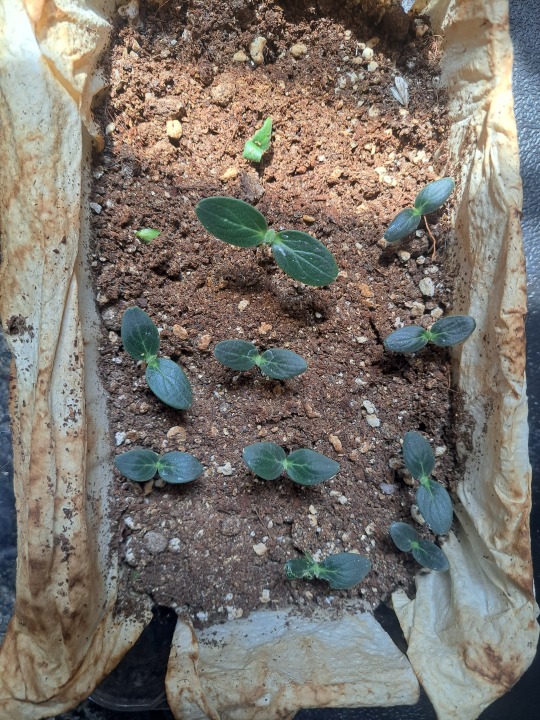
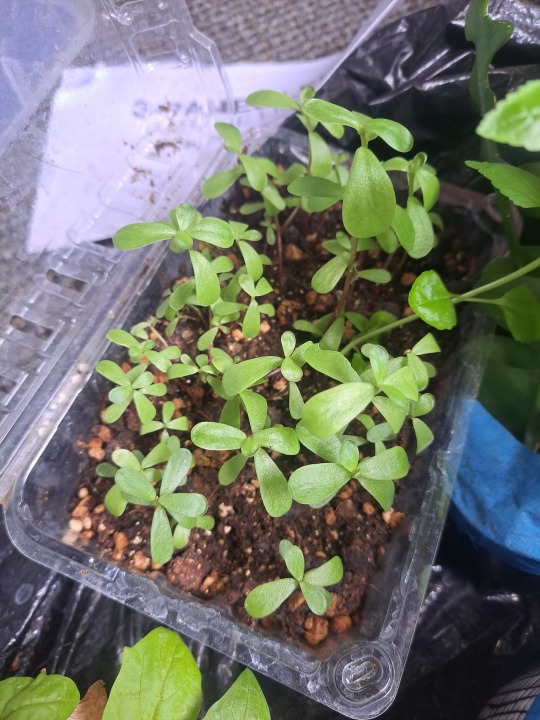
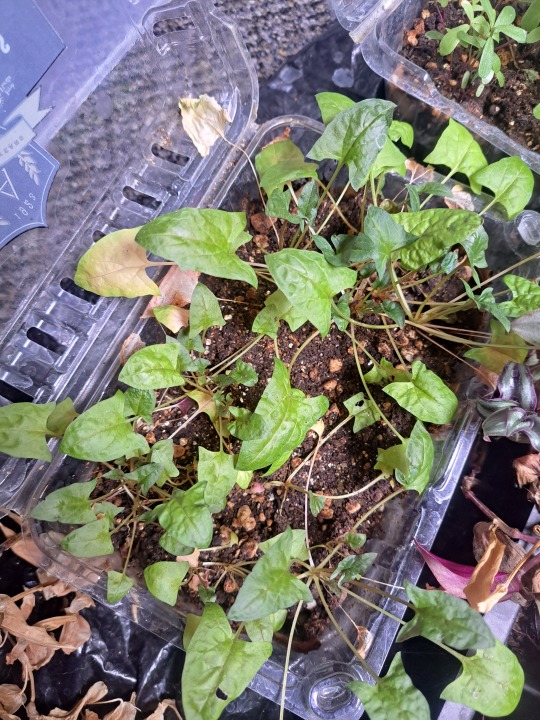
Gardening try 2
#an unfortunate accident killed most of the sprouts I mentioned earlier in this year#except for the praxxus cherry tomatoes#(which says something for their hardiness. Thanks Little Shop of Seeds - we'll miss you)#still need to get those outside though#the sunchokes are struggling but doing better#H-19 little leaf cucumber#(the deep green little guys)#honey rock cantaloupe#(small one above the cukes)#pussly#purslane#strawberry spinach#gardening
2 notes
·
View notes
Text
September 2022: The Tuesday & Wednesday Post
Seen while walking, pink purslane growing in a crack in the curb:
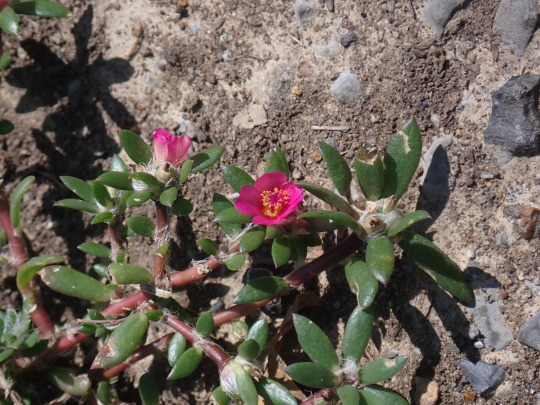
Burgundy & Alabama red okra found at the community garden’s garden waste dump. We are going to let them dry for seed collecting:
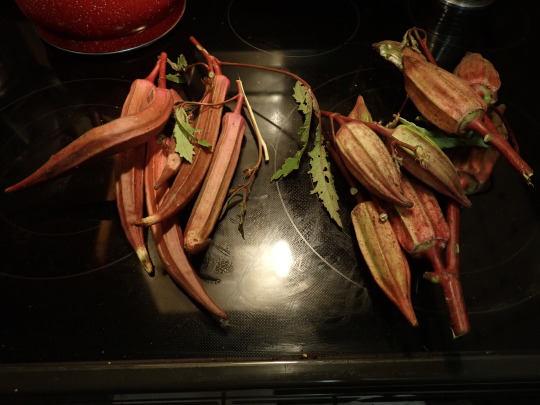
Tuesday’s Plot 420 harvest:
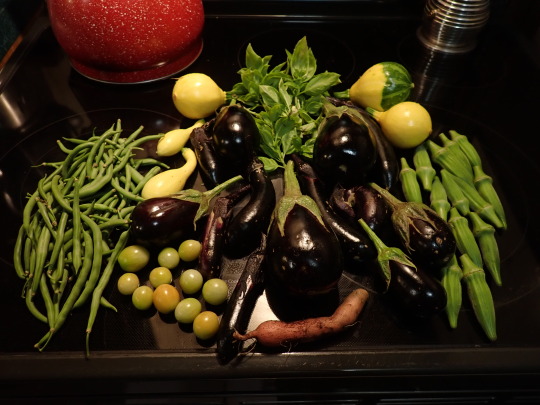
Chimichurri kabobs:
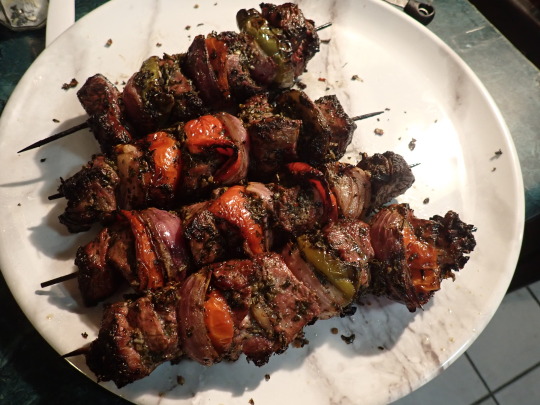

Wednesday’s backyard garden harvest:
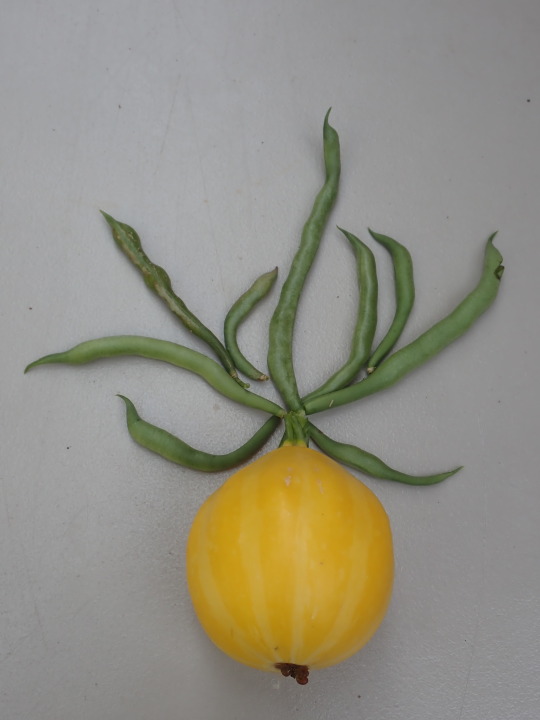
I hung up some of the sunflower heads that we collect from the community garden’s garden waste dump for the birds:
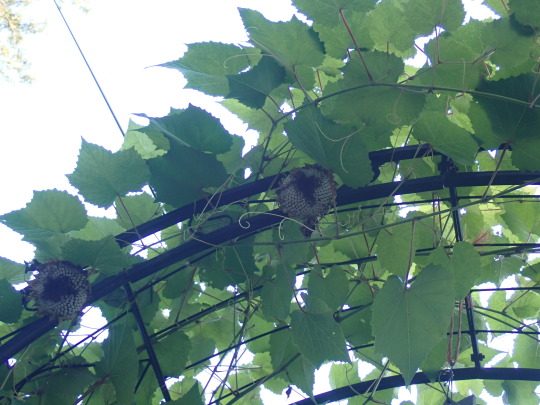
The mystery cucurbit’s fruit is looking more like a proper pumpkin every day:
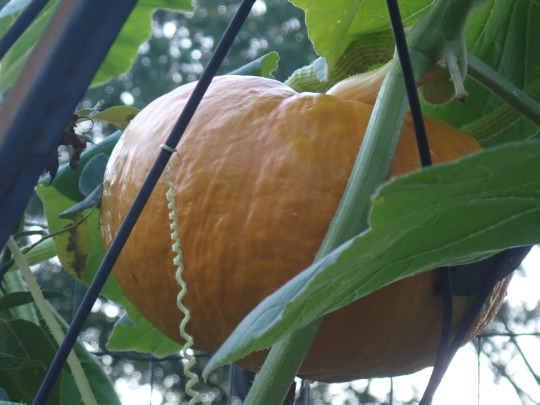
The volunteer snapdragon in the succulent container turns out to be yellow:
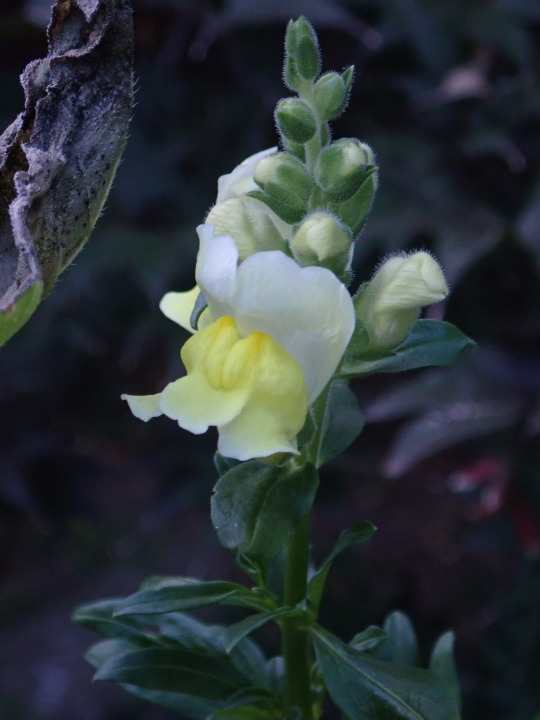
Curbside find one:

Curbside find two - sure it looks like rubble but it has endless uses in the garden:
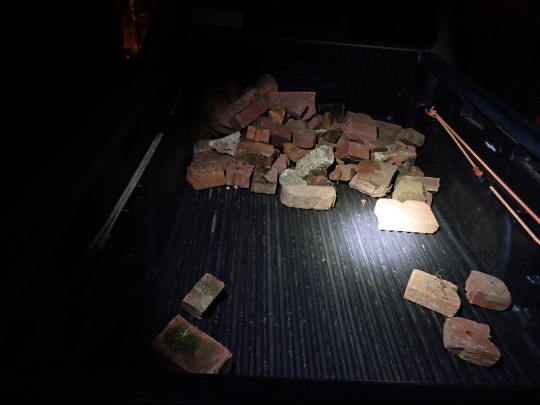
#seen while walking#wildflower#pink purslane#okra#burgundy okra#alabama red okra#seed collecting#community garden#shelby county community garden#plot 420#homegrown vegetables#basil#crookneck squash#lemon squash#eggplants#pole beans#clemson spineless#tomatoes#sweet millions#sweet potato#dinner#grilling#kabobs#chimichurri#sweet corn#grapevine#sunflowers#pumpkin#garden#backyard garden
3 notes
·
View notes
Text
you know how people say "cats domesticated themselves?" I find this statement irksome because as i've been studying plants and particularly weeds, a theory has slowly been forming in my head about domestication that makes a lot more sense than other theories.
Basically, I think everything domesticated itself. Or rather, domestication involves adaptation and active participation on both sides.
Evidence for this is found in studying weed and crop plants—truth be told, most weeds are or were also crops.
Amaranthus, the genus that gives us the most costly USA agricultural weeds? All edible and healthy, and several members of the genus are domesticated. They were staple crops for Mesoamerican empires.
Kudzu, the vine so aggressive in the USA it turns trees into looming kudzu monoliths? It's been bred and cultivated by humans since the Neolithic in its native range, in China it was one of the main sources of fiber for cloth for MILLENNIA to the point that the Zhou dynasty had a whole government office of kudzu affairs. Kudzu roots are edible and they can be as tall as a human and weighing over 200 pounds, you can make them into flour, make noodles out of the flour, you can process them down into a starch and use it just like potato or tapioca starch and make all sorts of sauces and confections and stuff out of it. In Japan it was used for clothes too, if you see pictures of clothes worn by a samurai that's probably kudzu! It has loads of unresearched phytochemicals that probably have medicinal use, it's good for making paper, a researcher even made a biodegradable alternative to plastic out of it
Yellow Nutsedge is a food crop, Purslane is a food crop, at least some species of morning-glories are food crops, crabgrass is a food crop, Nettles are food AND fiber, Milkweed is food and fiber too, Broadleaf Plantain is food and medicinal, Dandelion is food and medicinal AND great companion plant (they used to sell them in seed catalogues around the 1890's or so!) and have y'all ever seen queen-anne's-lace along the side of the road? THATS CARROTS. That's the wild ancestor of carrots! (ofc don't eat anything you aren't 1000% sure you can identify)
Simply put. A weed is a plant that has co-evolved with humans. And most of them are Like That because they co-evolved with us. And honestly I reckon that many plants were domesticated in the first place because they liked to grow in disturbed environments near human settlements and agricultural fields.
Now thinking about this in terms of animals...when our domestic species were first domesticated, there weren't fences, there wasn't "inside" or any controlled environment to bring animals into, and if you tried to overpower or coerce any of those species, they would 100% just kill you. It makes a lot more sense if the humans were just following herds around, and it gradually developed into protecting those herds from predators and tending to them more intentionally until we were kind of just part of the herds ourselves.
a lot of people are familiar with Biblical stories and metaphors about shepherds...it's clear those guys were basically living with sheep 24/7. They were assimilated to the sheep lifestyle.
this theory kinda suggests that we've lost the ability to domesticate new animal species to some extent because domestication has never really involved removing an animal from its natural environment. Feeding wild animals and trying to socialize them to humans isn't in line with the mutualistic nature of domestication because it's trying to change the animal to our whims, and usually decreases the fitness of the animal rather than increases it. And domestication probably takes a long long time to reach the level where an animal can be a "pet" instead of a more distant form of domestication where the association is not as close.
EXCEPT. Animals that adapt to our environment are prime candidates for domestication. This actually checks out because rats and mice are some of the most recently domesticated animals, iirc. Basically, pest animals are the most likely to be domesticated because they've already started evolving into a relationship with us. Just like weeds.
An interesting side note is how both animals and plants can de-domesticate and become "weeds/pests" again. Like "weedy rice" is becoming a problem in some crops where rice has evolved into a weed. And with animals, there's pigeons who were domesticated by us and now their habitat is cities because they co-evolved with us.
4K notes
·
View notes
Text
Went to take a pic of my newly cleaned kitchen, and heard nibbley noises from the box in my bathroom that contains all my medicinal plants and incenses. Oh no.
Open the box, little mouse eyes blink up at me. I’m like, “Awww shit what are you even eating in there?? Are you eating my medicine? That’s so uncool, man.”
So yea, at least two (2) mice in my house just ate maca and gingko biloba. I hope they remember I didn’t kill them when they’re boning with the natural Viagra they ate.
#I didn't end them#i emptied the box#then dumped them in the trash bins outside#washed all the jars and put them in a new box#they ate my Mullein seeds and my Purslane seeds too#RIP wild rocket seeds#they didn't eat my Synaptolepis kirkii though#mice#mouse#pests#too fucking cute#I have traps#but they ignore them utterly#i wonder how they foundthe blue water lily#i bet it was lovely#psycoactive#hallucenogenic#lol
0 notes
Text
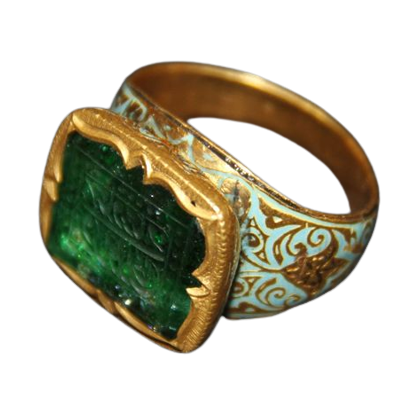


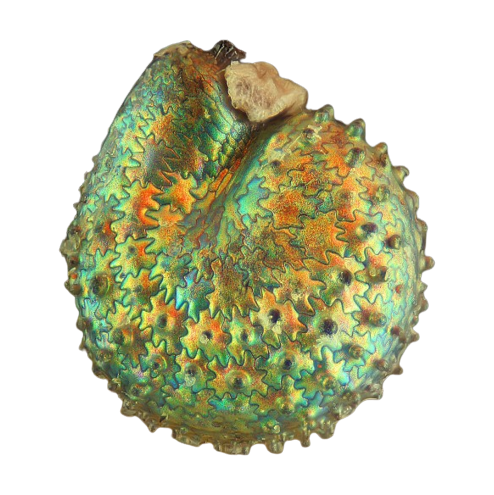





Random PNGs, part 155.
(1. Emerald ring, 2. Madame Leota soap, 3. Loetz glass inkwell, 4. Purslane seed, 5. Die, 6. Armenian money bag by Bedros Zakaraian, 7. The Garden of Love by Franz Toussaint, 8. Apophillite (?), 9. Loetz glass bowl)
3K notes
·
View notes
Text
If anyone has any suggestions of drought resistant perennials that wildlife like to browse, I'm still insane and hoping to plant some things for them.
The plan is to make a fenced section with things for the deer/rabbits etc and let it spread out naturally and eventually remove the fence, so I need things that will either firmly root themselves (so they can't be pulled out very easy, tulips are an example, I think chicory might be an option) or will self-seed enough that it doesn't matter (I'm thinking clover esp for this, might be a fuck and plant some purslane... cus I like munching on it too).
I was gonna do a field of wildflowers in the front yard but right now I'm honestly thinking get some perennials established, fill in with annuals and things the wildlife won't eat, and attempt to maintain a little something-something for the animals... stick a massive bird bath in the middle... hope no more animals collapse in the heat of summer in my front yard. 🙃
#I'm definitely planting succulents this year but idk... i might seed this fall with a food plot mix... and just see what happens#like... idk if I can maintain anything with the wildlife but it's their home too and I have sympathy#if I can establish some stuff that's weedy or that's perennial and hardy to browsing I think it'll maybe work out#I'd like to eventually move out some of the edible invasives that I don't prefer but I gotta figure out what would go in their places#i love the way the stork's bills look but I'm gonna have to control them at some point#if they get enough water they don't die back at all during winter and that's maybe an edge I don't want them to have#mostly cus the wildlife are totally over them#I'd like to think purslane would be a solid summer crop for them cus it's full of water and vitamin c... but it's also pretty low growing#so that'd mostly be for the rabbits#which is why I'm thinking chicory cus they get tall and they're rhizomous so they should root well and stay where i put them#i... kinda want to plant some more salad burnet cus it's handsome af and tall enough that the deer would probably dig it#it hasn't flowered yet so I haven't gotten to see if it seeds well#but if it does I'll probably transplant some for the deer/etc
1 note
·
View note
Text
What's really in that witch's cauldron?
Folk names for herbs
Ass' Ear- Comfrey
Bat's Wing- Holly Leaves
Beard Of Monk- Chicory
Bear's Foot- Lady's Mantle
Bird's Eye- Germander or Speedwell
Blind Eyes- Poppy
Blood From a Head- Lupine
Blood Of Ares- Purslane
Blood Of Hestia- Chamomile
Bloody Fingers- Foxglove
Calf's Snout- Snapdragon
Cat's Foot- Ground Ivy
Crow's Foot- Wood Anemone
Devil's Ear- Jack In The Pulpit
Devil's Plaything- Yarrow
Dew Of the Sea- Rosemary
Dog's Mouth- Snapdragon
Dragon's Teeth- Vervain
Elf Leaf- Lavender
Englishman's Foot- Common Plantain
Fairy Eggs- Nutmeg
Flower Of Death- Vinca
Goose Tongue- Lemon Balm
Graveyard Dust- Mullein
Hawk's Heart- Wormwood
Juno's Tears- Vervain
Jupiter's Beard- Sempervivums
Lion's Foot- Lady's Mantle
Little Faces- Viola
Man's Bile- Turnip Sap
Mortification Root- Rose of Sharyn
Nose Of Turtle- Turtlehead, Chelone
Nosebleed- Yarrow
Our Lady's Tears- Lily Of The Valley
Old Man's Flannel- Mullein
Ram's Head- Valerian
Scale Of Dragon- Tarragon
Semen Of Ares- White Clover
Semen Of Hermes- Dill
Serpent's Tongue- Dog's Tooth Violet
Sparrow's Tongue- Knotweed
Tree Of Doom- Elder
Unicorn Root- Boneset
Weasel Snout- Yellow Archangel
Wool Of Bat- Moss
Body Parts as Plants:
Eye- Blossom or Seed
Heart- Bud or Seed
Beak, Bill or Nose- Seed, Bud or Bloom
Tongue or Teeth- Petal or Leaf
Head- Blossom
Tail- Stem
Hair- Dried Herbs or Stringy Parts Of Herbs
Privates, Genitals Or Semen- Seeds Or Sap
Blood- Sap
Guts- Roots or Stalk
Paw, Foot, Leg, Wing or Toe- Leaves
Animals as Plants:
Toad- Sage
Cat- Catmint
Dog- Grasses, Specifically Couchgrass
Frog- Cinquefoil
Eagle- Wild Garlic
Blue Jay- Laurel
Hawk- Hawkweed
Lamb-Wild Lettuce
Nightengale- Hops
Rat- Valerian
Weasel- Rue
Woodpecker- Peony
I borrowed this from:
#witchcore#witchy#witchcraft#witch#witchblr#magick#cast spells#moon#crystals#moon magic#witches of tumblr#witches#witchyvibes#kitchen witch#witch community#witch tips#witchaltar#witchlife#witchythings#spells#grimoire#spellcraft#cleansing#spellwork#witch tip#my spells#herbsforspells#herbs#herbalist#witch herbs
8K notes
·
View notes
Text
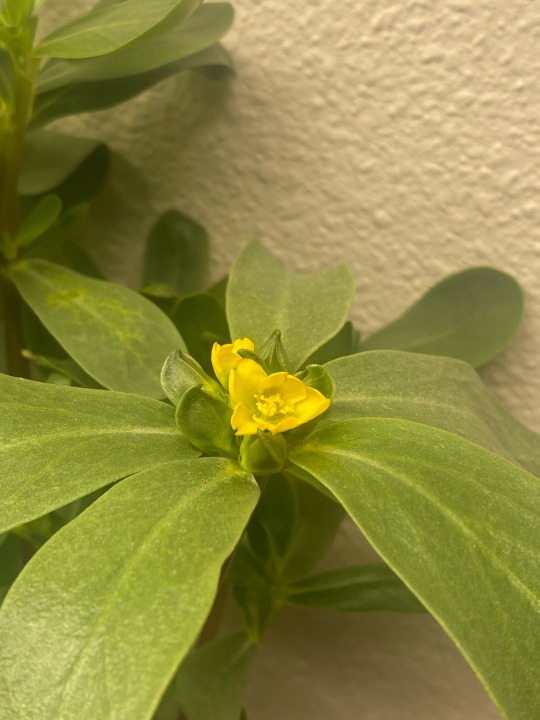
The purslane flowered! I honestly didn’t realize they could have fully opened flowers like this. I had just assumed they were cleistogamous since I hadn’t seen the flowers and just saw the fruit and seeds but I guess in certain conditions they open up. Or maybe they open up normally but are just just extremely short-lived?
18 notes
·
View notes
Text
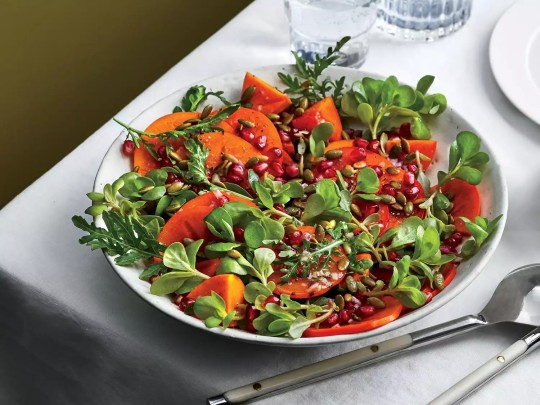
Persimmons, Pomegranate, and Purslane with Pepitas (Vegan)
#vegan#raw vegan#salad#appetizer#pomegranate#arugula#persimmon#purslane#wild greens#wild weeds#pumpkin seeds#shallots#orange juice#olive oil
8 notes
·
View notes
Note
Have you got any suggestions for a Seelie Fae? Maybe with some alcoholic drinks? (im 20, legally allowed to drink here in Britain)
The only thing I dont really like is mushrooms
Thanks
Seelie Fae always remind me of spring and summer, so here's a bunch of recipes you might like (no mushrooms included!)
Herb and Veggie Pasta Salad
Egg and Veg Brunch
Herby Rigatoni with Pine Nuts and Dates
Vegetable Ribbon Tart
Smoked haddock and leek chowder with quail eggs
Snapper fillets with fennel vinaigrette and dandelion
Baby Leek Galettes
braised rabbit pappardelle with mixed spring vegetables
Sunflower Seed And Honey Wheat Bread
Fruity Purslane Salad
Savory Bread Pudding
Buttermilk Chive Popovers
A ton of tasty Edible Flower recipes! (both sweet and savory!)
Even More, Now With Alcohol!
Tons Of Spring Cocktails
Rustic Honey Cake
Hummingbird Cake
Lavender Honey Cheesecake
I hope this helps~!!
#otherkin food#otherkin#recipes#kin stuff#seelie fae#faekin#fairykin#faeriekin#seeliekin#spring recipes#summer recipes#veggies
15 notes
·
View notes
Text
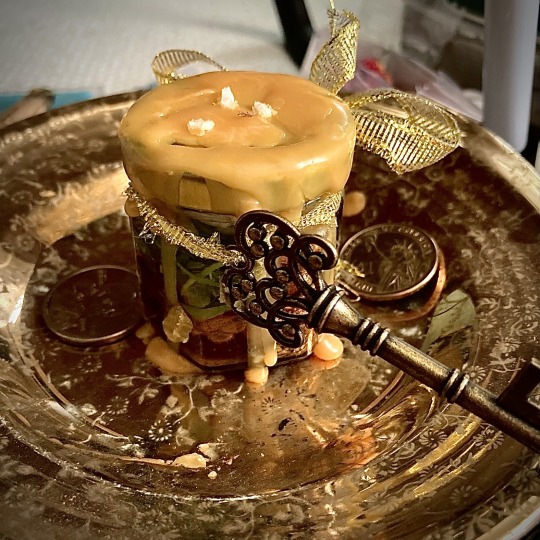
Prosperity and luck jar.
Gathered from my pantry and garden:
Pantry:
Cinnamon sugar & Cinnamon sticks -Abundance protection, success, healing, power, luck, fertility, manifestation, Prosperity, energy booster, protection
Ginger- Money, power, success, enhance magic, personal confidence, draws adventure and new experiences, speed boost for magic endeavors.
Rosemary- acceptance, clarity, healing, mental powers, protection, purification
Thyme- courage, healing, health, psychic powers, purification
Basil- fidelity, protection, wealth, luck, success
Clove- money, strong protection, dispels negative energy
Cayenne- clarity, repels negative energy, Empowerment, protection, speed up spell results, strength
Sesame- money, new opportunities
Rice- abundance, fertility, money, protection
Nutmeg- clarity, enhance intellect, good luck, prosperity, confidence
Garden:
Comfrey- money, safety during travel
Dandelion leaves- Calling Spirits, Divination, Wishes
Clover flower and leaves- business, fidelity, money, protection, success
Purslane- happiness, luck, protection
Blackberry & leaves - healing, money, protection
Huckleberry and leaves- Dream magic, hex breaking, luck, protection, good fortune
Pecan leaves- Employment, money
Buckwheat tip (flowers and leaves )- Money, protection
Rose leaves- lasting love, harmony, dreams, happiness, healing, divination, luck, protection
Also used Lammas Full Moon/sun water. (sat it out last night and opened right before the spell)
Orange candle (scented French toast and pumpkin butter)
Sealed the jar with the wax. Wrapped a key with gold ribbon
Three rices grains on top.
Gold plate sat two dollar coins on either side.
I wore an emerald necklace with silver chain, gifted to me by my fiance. I attache a citrine pendant to it along side the emerald.
Emerald and silver engagement ring
Phantom Amethyst braclet
Celestite bracelet.
Actively chosen colors:
While picking the items from the garden I wore all light blue: (Psychic awareness, Intuition, Opportunity, Peace, Understanding, Quests, Safe journey, Patience, Tranquility, Ward depression.)
Orange candle: (Creativity, Self-expression, Strength, Healing, Pulling things to you, Adaptability, Luck, Vitality, Encouragement, Clearing the Mind, Dominance, Energy both Physical and Magickal, Legal matters, New opportunities, Career, Overcoming addiction, Joy, Business success, Ambition, Fun, Action, Investments.)
For the gold plate, ribbon: (Positive attitude, Power, Physical Strength, Success, Achievement, Mental growth, Healing energy, Intuition, Divination, Fortune, Luxury, Male energy, Understanding, Wealth spells and magick. Associated with the Sun God and the power of the light.)
A note about from my garden: All were picked fresh before doing the spell,
Did not have any dandelion flowers or seed.
I added one blackberry. The only one that was fully ripe, lol.
The huckleberry is from the nightshade type of huckleberry. Do not know if that changes things.
I have two pecan saplings so I took a leaf from both.
Rose, I only took leaves, do not have many flowers so I didn't want to take them.
A note toward ingredients. I mixed and matched and found ones I had access to. Please be open to changing up and making your own.
23 notes
·
View notes
Text
The Cavalry of Maglor’s Gap and Lothlann and other world building for the region (Part One)
World Building Masterlist
Like my other Fëanorian World Building posts I focus mainly on layout/hierarchy, population, resources and trade, and homes and construction.
Please always feel free to ask more! For this location or any others! And feel free to suggest locations for world building posts
Maglor’s Gap is an area of Northeastern Beleriand. It lies at the Southern end of the plains of Lothlann with the March of Maedhros on the West and Mount Rerir and Thargelion at the East.
We sadly know very little about the horsemen of Maglor other than that they were burned alive in Lothlann during the Dagor Bragollach. But as Tolkien World Building is my favorite thing, here’s some speculation
The cavalry is made up of over 300 Noldorin riders though duty is cycled so there is usually a group of twenty to fifty inactive or in less intensive tasks They are primarily a defensive measure, protecting Eastern Beleriand from invasion from the North.
Most carry a sword though there are a significant number of archers as well. The cavalry is highly disciplined and trained in both solo and smaller missions as well as coordinated combat operations involving large numbers
The Cavalry live in a number of low, wooden halls located in the foothills. Smaller, cabin like stations dot the route North towards Ard Galen where some stay during longer missions
The horses are bred in Lothlann and graze largely in the wild plains and meadow steppes. About forty elves are involved full time in their care during the watchful peace. The number drops during more dangerous times
The organization and governance of the gap is somewhere between that of the highly organized and fortified Himring and the loosely governed Himlad with no central citadel. Few records are kept and non military positions outside healers are largely temporary and shared ones, the exception being a few who deal primarily with trade and the acquisition of resources
On that note, resources primarily come from Eastern Beleriand with some imports from East of the Ered Luin and elsewhere in Beleriand. Fiber crops are not grown in the Gap and materials for clothing are accessed through trade with Thargelion*. The material is generally already processed and cleaned and requires only fashioning into clothes. Linen, wool, and silk are the most used with other furs going into linings. Leather is also imported from Himlad and Thargelion.
Some clothing is made by individuals who acquire the materials through hunting
*who also get many materials from elves, men and dwarves East of the Ered Luin
Maglor’s Gap does have a small fortress in the more mountainous Northeast near the border to Thargelion. This served temporarily as Maglor’s own home too. It was built from stone and earth to blend into the surrounding landscape (though most was above ground unlike Nargothrond
Fish from the two nearby rivers and various streams are caught often for food and are eaten more than other meat. Seeds and bread made from various flours are also eaten along with often bitter wild vegetables such as wild spinach, purslane, lamb’s quarters, red and green dandelions, etc. Salt is another traded resource. Butter and any other dairy products are somewhat rare. Goat milk products are available somewhat more than cow as goat and sheep are more common in Eastern Beleriand
The majority of the Cavalry perished during Dagor Bragollach. The rest fled towards Himring with a small number traveling further South
77 notes
·
View notes
Text

Purslane benefits your health in many ways, as it is a weed that is packed with nutrients.
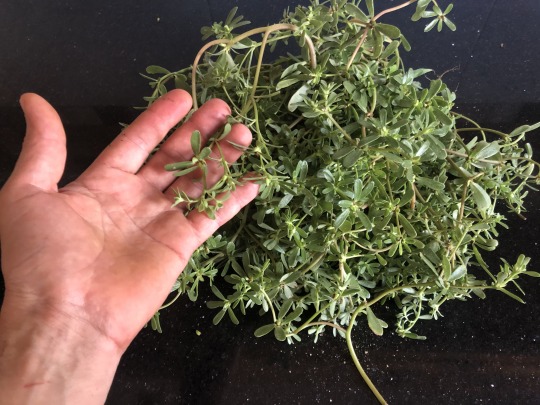
Purslane is truly a superfood. If purslane is growing in your garden
after you have known its benefits, you need to think twice before pulling it out and throwing it away!
Know more about purslane benefits
#medicinal plants#garden#gardenchat#organic gardening#backyard#house plant#my plants#plant#plant life#plant lover#plantblr#plantcore#plantlover#plants#gardens#healthyplants#eathealthy#plantbased#plant blog
18 notes
·
View notes
Text
Foraging! (1/?)
With the way the world is and the direction we're headed in as a society, it's becoming increasingly essential to become as self-reliant as possible. Unfortunately in just a few generations, the “leaders” of our world have nearly wiped all of the old common knowledge away. Capitalist consumerism has turned us into reliant beings who - for the most part - have stopped doing things that are in sync with the earth. We rely on stores for everything - from food to “convenient” items such as paper products, cleaning supplies, and other home goods. But did you know that with a little work you can make everything you need? For a long time i didn't either.
Foraging is an important skill that everyone should know! You can find most of the things you’d need for your daily life.
Some of my favorite foods to forage for are predominantly greens, but some plants also have edible seeds and roots as well. Most of the best forage is considered “weeds” by our society, which is unfortunate. Take lamb’s quarter for example; a common weed known around the world that is high in fiber, vitamin A, and vitamin C. It also contains a bunch of other important nutrients such as calcium, omega-3, omega-6, and manganese.
Another nutritious “weed” is purslane. It’s high in omega-3’s and potassium. One thing to be aware of is oxalic acid, which is found in purslane, known to be an anti-nutrient. While those with kidney issues should use caution with this compound, cooking the plant before consumption can help break down the acid.
Along with those, I also enjoy bitter dock, which is loaded with vitamin A and potassium. The roots of this plant are also known for having a detoxifying effect on the liver.
Many of the weeds in the US are renowned across the globe and a perfect example of that is amaranth. An ancient grain that is a staple in many countries is regarded as a pest here. This impressive plant has been able to develop a resistance to glyphosate (a cancer-causing chemical used in Roundup), which will likely become highly important in years to come. This plant’s leaves and seeds are edible and highly beneficial, containing vitamins A and C, calcium, folate (leaves), and protein (seeds). A fun bonus to this awesome plant: you can pop the seeds (~100k per plant) like popcorn! There’s a reason why this plant is loved around the world.
Since we’re discussing edible weeds, this beginner post would not be complete if we didn’t discuss dandelions. High in lots of vitamins such as A, K, and C, this plant is highly nutritious. The best part of this plant (in my opinion)? This plant is basically heart medicine AND the ENTIRE plant is edible! My favorite part of the plant would have to be the roots, they taste delicious and become perfectly tender when added to soups or sautees. The roots also help metabolize estrogen (while important), which can cause major problems in both men and women when in high concentrations. Since it can be found in tap water (in the US), everyone should try to consume dandelion to reduce any harmful effects of it.
I will be focusing some time on discussing a lot of the different plants you can forage for, as well as their uses, so stay tuned for that!(:
{will add my sources in a bit, I just wanted to get this up a while(: }
14 notes
·
View notes